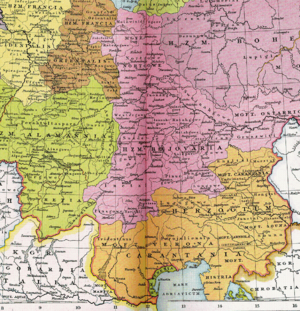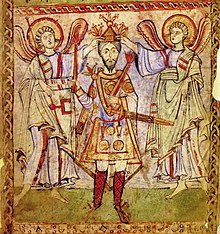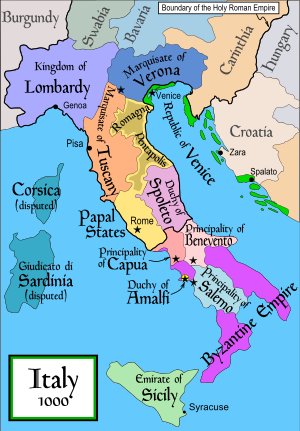Otto II, Holy Roman Emperor
| Otto II | |
|---|---|
 Portrait of Otto II on the Registrum Gregorii illuminated manuscript, c. 985. | |
| Holy Roman Emperor | |
| Reign | 7 May 973 – 7 December 983 |
| Predecessor | Otto I |
| Successor | Otto III |
| King of Italy | |
| Reign | 25 December 980 – 7 December 983 |
| Predecessor | Otto I |
| Successor | Otto III |
| King of Germany | |
| Reign | 26 May 961 – 7 December 983 |
| Predecessor | Otto I |
| Successor | Otto III |
| Born | 955 Duchy of Saxony, Kingdom of Germany |
| Died | 7 December 983 (aged 27–28) Rome, Papal States |
| Burial | |
| Spouses | Theophanu (m. 972) |
| Issue |
|
| Dynasty | Ottonian |
| Father | Otto the Great |
| Mother | Adelaide of Italy |
Otto II (955 – 7 December 983), called the Red (der Rote), was Holy Roman Emperor from 973 until his death in 983. A member of the Ottonian dynasty, Otto II was the youngest and sole surviving son of Otto the Great and Adelaide of Italy.
Otto II was made joint-ruler of Germany in 961, at an early age, and his father named him co-Emperor in 967 to secure his succession to the throne. His father also arranged for Otto II to marry the Byzantine Princess Theophanu, who would be his wife until his death. When his father died after a 37-year reign, the eighteen-year-old Otto II became absolute ruler of the Holy Roman Empire in a peaceful succession. Otto II spent his reign continuing his father's policy of strengthening Imperial rule in Germany and extending the borders of the Empire deeper into Southern Italy. Otto II also continued the work of Otto I in subordinating the Catholic Church to Imperial control.
Early in his reign, Otto II defeated a
With domestic affairs settled, Otto II would focus his attention from 980 onward to annexing the whole of Italy into the Empire. His conquests brought him into conflict with the
Otto II died suddenly in 983 at the age of 28 after a ten-year reign. He was succeeded as Emperor by his three-year-old son Otto III, plunging the Empire into a political crisis.
Early years
Birth and youth
Otto II was born in 955, the third son of the
Needing to put his affairs in order prior to his descent into
Heir apparent

Though Otto I was crowned Emperor in 962 and returned to Germany in 965, the political situation in Italy remained unstable. After almost two years in Germany, Otto I made a third expedition to Italy in 966. Bruno was again appointed regent over the eleven-year-old Otto II during Otto I's absence.
With his power over northern and central Italy secured, Otto I sought to clarify his relationship with the
Otto II's coronation allowed marriage negotiations to begin with the East. Only in 972, six years later, under the new Byzantine Emperor
Even after his coronation, Otto II remained in the shadow of his overbearing father. Though the nominal co-ruler of the Empire, he was denied any role in its administration. Unlike his earlier son Liudolf, whom Otto I named Duke of Swabia in 950, Otto II was granted no area of responsibility. Otto II was confined primarily to northern Italy during his father's time south of the Alps. After five years away, the Imperial family returned to Saxony in August 972.
On 7 May 973, Otto died of fever, and Otto II succeeded his father as sole Emperor without meeting any opposition.[3] Otto II spent his reign continuing his father's policy of strengthening Imperial rule in Germany and extending it deeper into Italy.
Reign as emperor
Coronation and domestic strife
When Otto the Great died, the smooth succession to the imperial throne of Otto II had long been guaranteed. Otto II had been king of Germany for twelve years and Emperor for five at the time of Otto the Great's death. Unlike his father, Otto II did not have any brothers to contest his claims to the throne. On May 8, the nobles of the Empire assembled before Otto II and, according to the Saxon Chronicler
The domestic problems Otto the Great faced between 963 and 972 had not been resolved by his death. The Saxon nobility continued to resist the
Otto the Great also failed to clarify affairs in Italy prior to his death. Otto died soon after the appointment of
Following his coronation, a rift developed between Otto II and his mother, the
Conflict with Henry II
Otto II sought continued peace between himself and the descendants of his uncle
On 12 November 973, Burchard III died with no heir: his union to Hadwing, sister of Henry II, had produced no children. With no clear successor, Henry II demanded that Otto II name him as the new Duke of Swabia. The Emperor sensed the far-reaching ambitions of his cousin and denied his request. Instead, Otto II named as Duke his nephew Otto, son of his half-brother Liudolf, Duke of Swabia. Prior to his appointment, Otto had been a long-time opponent of Henry II's expanding influence in Swabia. By naming a descendant of his half-brother instead of his cousin, Otto II reinforced his father's policy of appointing close family members to key posts throughout the Empire. This appointment elevated the descendants of Otto the Great above those of Henry I in the selection process, further dividing Otto II and Henry II.
The appointment of Otto as Duke of Swabia was taken by Henry II as an assault on his claim to the Imperial throne and a slight to his honor.
By 976, Henry II had returned to Bavaria. Whether Otto II released him from prison or he escaped is not known for certain. Upon his return, Henry openly rebelled against Otto II, claiming rulership over the Empire for himself. Henry II mobilized the Saxon nobility against Otto II. In particular, Henry II had strong connections to Margrave

With Henry II deposed, in July 976 Otto II issued far-reaching edicts on the reorganization of the southern German duchies. Otto II reduced the size of Duchy of Bavaria by almost a third. From the excised Bavarian territory, Otto II established the Duchy of Carinthia in southern Germany. By depriving Bavaria of the March of Verona, Otto II considerably reduced the influence of the Bavarian dukes in northern Italy and in general Imperial policy regarding Italy. Otto II gave the newly diminished Duchy of Bavaria to his relative Otto, the Duke of Swabia,[3] and appointed Henry III, son of the former Bavarian Duke Berthold, as Duke of Carinthia. These appointments continued his policy of appointing individuals who had no political links to Otto the Great, including those who had even rebelled against him.
With matters in southern Germany settled, Otto II turned his attention to defeating and capturing Henry II. After a failed first invasion into Bohemia, Otto II marched to Bohemia a second time in August 977. While in Bohemia,
While Otto the Great had pardoned rebellious family members for their crimes, Otto II followed a different policy. Instead, Otto II hoped to subordinate the Bavarian line of Ottonians to his Imperial authority. Henry II's four-year-old son, also named Henry, was sent to Hildesheim to study for an ecclesiastical career. It appears Otto II intended to end the Bavarian Ottonians' secular control of Bavaria. Under a new Duke, Bavaria would remain a remote area of the Empire. Otto II would only visit the Duchy three times during his reign, in all cases accompanied by the military.
War with Denmark
In 950, Otto the Great had subdued the
War against France
Before Henry II's civil war in southern Germany erupted, Otto II was faced with disputes in western Germany. The brothers
Otto II's support of Charles, however, infuriated the French king, who claimed the Duchy as his own territory. After occupying Aachen for five days, Lothair returned to France after symbolically disgracing the city.
Otto II convened the Imperial Diet in mid-July at
With peace concluded, Otto II returned to Aachen to celebrate Pentecost, and then moved towards Nijmegen. During the journey, in late June or early July 980, the Empress Theophanu gave birth to the Imperial couple's only son: Otto III.
Reign in Italy
Papal politics
With his rule north of the Alps secured and with the birth of his heir, Otto II shifted his focus to Italy. The situation south of the Alps was chaotic.
In 979 Benedict VII's position as ruler of Rome was threatened, forcing the Pope to withdraw from and seek the aid of the Emperor. Accepting the Pope's call for aid, Otto II and Theophanu, along with their infant son
In October 980 the Imperial court arrived in
Otto II proceeded to hold court in Rome, making the city his Imperial capital, where he received princes and nobles from all parts of western Europe.[9]
Venetian affairs

The relationship between the Empire and the
Otto I's military protection of Pietro IV ensured his hold over power in Venice despite his autocratic tendencies over the republican city. In 973, however, Otto I died. With Otto II busy suppressing
Pietro I Orselo's conciliating policy towards the Empire was ineffective. After having ruled Venice for about two years, Pietro I voluntarily abdicated to become a monk, allowing the pro-Ottonian Vitale to return to Venice as Doge in 978, restoring the city's friendly relationship with the Empire. However, Vitale's reign was short (less than two years) and he too abdicated to become a monk. With the position vacant, the pro-Byzantine Tribuno Memmo became the new Doge in 979. With the change in leadership, Otto II was reluctant to renew the city's commercial agreements which his father had previously granted to the city. It was only after the intervention of Otto II's mother, the dowager empress Adelaide of Italy, that the Emperor renewed the agreements.
Violence erupted in Venice during 980 due to tensions between the pro-Ottonian Coloprini family and the pro-Byzantine
Religious policy
Otto II followed the policy of his father in expanding the importance of the Church in his Empire, in particular the importance of
Following the suppression of
Otto II employed monks among his top political advisers, including
Southern expansion

In regard to his Italian policy, Otto II went beyond the goals of his father. Not satisfied with the territorial gains made under Otto I, Otto II's policy was based not only on securing his power in Rome and cooperating with the Papacy, but also on gaining absolute dominion over the whole of Italy. Influenced by his wife, who was hostile to the return of the
The Ottonians' chief lieutenant in central and southern Italy had long been the
Pandulf's death in 981 deprived Otto II of one of his primary lieutenants. Pandulf's lands were partitioned among his sons, though further quarrels between the local Lombard princes soon followed.[13] Pandulf's older son Landulf IV received Capua and Benevento while his younger son Pandulf II received Salerno. Upon hearing of Pandulf's death, Otto II, ruling from Rome, traveled south to install Thrasimund IV as Duke of Spoleto. Then, Pandulf's nephew Pandulf II was given Benevento when Otto II partitioned Landulf IV's territory, with Landulf IV keeping Capua. Finally, Duke Manso I of Amalfi deposed Pandulf II of Salerno in 982.
By 982 the entire area once ruled by Pandulf had collapsed, weakening Otto II's position against the Byzantines. The Byzantines still claimed sovereignty over the Lombard principalities, and the lack of a single leader to prevent their advances into Lombard territory allowed the Byzantines to make inroads further north. Otto II attempted on several occasions to reunify the Lombard principalities politically and ecclesiastically into his Empire after Pandulf's death. Though he unsuccessfully besieged Manso I in Salerno, Otto II ultimately obtained the recognition of his authority from all the Lombard principalities.

With his authority reestablished over the Lombard princes, Otto II turned his attention towards the threat from Muslim Sicily. Since the 960s the island had been under
Otto II's troops marched on Byzantine-controlled Apulia in January 982 with the purpose of annexing the territory into his Empire. (along with the Imperial treasury) in the city and marched his army to pursue the Muslim force.
Unable to flee back to his stronghold in Sicily due to an Ottonian naval blockade, al-Qasim faced Otto's army in what has been come to be known as the
The Imperial defeat shocked the political makeup of
Imperial crisis
Succession issues
The defeat at Stilo forced Otto II to flee north to Rome.[21] He then held an Imperial Diet at Verona on Pentecost 983.[19] He sent his nephew Otto I, Duke of Swabia and Bavaria, back to Germany with news of the defeat and to call the German nobles to the assembly, but his emissary died en route on November 1, 982, in Lucca. News of the battle did cross the Alps, however, reaching as far as Wessex in England, signifying the magnitude of the defeat. Duke Bernard I of Saxony was heading south for the assembly when Danish Viking raids forced him to return to face the threat.
At the assembly, Otto II appointed
The most important action taken by Otto II at the assembly, however, was to secure
Great Slav uprising

Around the year 982, Imperial authority in Slavic territory extended as far east as the
Soldiers from the
The Danes took advantage of the Slavic revolt and invaded the March of Schleswig along the Empire's northern border while the Sorb Slavs invaded and conquered the March of Zeitz from the Saxons.[19]
Sudden death and political turmoil
In July 983,
Otto II's three-year-old son
In 976, Otto II had deposed
The early death of Otto II and the ensuing events proved to be a serious test for the Empire. Despite having a child under the regency of his mother as a ruler, the structure established by
Character
| German royal dynasties | |
|---|---|
Family tree of the German monarchs Category:Ottonian dynasty | |
Succession | |
| Preceded by Conradine dynasty | |
| Followed by Salian dynasty | |
Otto was a man of small stature, by nature brave and impulsive, and by training an accomplished knight. He was generous to the church and aided the spread of Christianity in many ways.
Family and children
Otto II was a member of the
.Otto II had only one known wife. On 14 April 972, Otto II married Theophanu,[31] a Byzantine princess of the Phokas family who was the cousin of reigning Byzantine Emperor John I Tzimiskes. The two had at least five children:
- Adelheid I, Abbess of Quedlinburg and Gandersheim,[31]born 973/974, died 1045.
- Otto III, Holy Roman Emperor, born end June/early July 980.[31]
- A daughter, a twin to Otto, who died before October 8, 980.
Ancestry
| Ancestors of Otto II, Holy Roman Emperor | ||||||||||||||||||||||||||||||||||||||||||||||||||||||||||||||||||||||||||||||||||||||||||||||||||||||||||||||||||||||||||||||||||||||||||||||||||||||||||||||||||||||||||||||||||||||||||||||||||||||||||||||||||||||||||||||||||||||||||||
|---|---|---|---|---|---|---|---|---|---|---|---|---|---|---|---|---|---|---|---|---|---|---|---|---|---|---|---|---|---|---|---|---|---|---|---|---|---|---|---|---|---|---|---|---|---|---|---|---|---|---|---|---|---|---|---|---|---|---|---|---|---|---|---|---|---|---|---|---|---|---|---|---|---|---|---|---|---|---|---|---|---|---|---|---|---|---|---|---|---|---|---|---|---|---|---|---|---|---|---|---|---|---|---|---|---|---|---|---|---|---|---|---|---|---|---|---|---|---|---|---|---|---|---|---|---|---|---|---|---|---|---|---|---|---|---|---|---|---|---|---|---|---|---|---|---|---|---|---|---|---|---|---|---|---|---|---|---|---|---|---|---|---|---|---|---|---|---|---|---|---|---|---|---|---|---|---|---|---|---|---|---|---|---|---|---|---|---|---|---|---|---|---|---|---|---|---|---|---|---|---|---|---|---|---|---|---|---|---|---|---|---|---|---|---|---|---|---|---|---|---|---|---|---|---|---|---|---|---|---|---|---|---|---|---|---|---|
| ||||||||||||||||||||||||||||||||||||||||||||||||||||||||||||||||||||||||||||||||||||||||||||||||||||||||||||||||||||||||||||||||||||||||||||||||||||||||||||||||||||||||||||||||||||||||||||||||||||||||||||||||||||||||||||||||||||||||||||
See also
- Kings of Germany family tree.
References
- ISBN 978-1783270248.
- ^ Duckett, p. 90
- ^ a b c d e f g h i j Reuter 2000, p. 254.
- ^ a b Richard P. McBrien, Lives of the Popes: The Pontiffs from St. Peter to Benedict XVI, (HarperCollins, 2000), 161.
- ^ Duckett, p. 100
- ^ a b c Comyn, p. 117
- ^ G. Labuda, Mieszko I, pp. 180–185; Marian Jedlicki, Stosunek prawny Polski, Poznań, 1939, p. 33
- ^ a b c Comyn, p. 118
- ^ a b c d e One or more of the preceding sentences incorporates text from a publication now in the public domain: Chisholm, Hugh, ed. (1911). "Otto II.". Encyclopædia Britannica. Vol. 20 (11th ed.). Cambridge University Press. p. 374.
- ^ a b c Comyn, p. 119
- ^ a b Duckett, p. 103
- ^ a b Duckett, p. 102
- ^ a b Sismondi, p. 29
- ^ John W. Bernhardt, in Gerd Althoff, Johannes Fried, Patrick J. Geary, eds. Medieval Concepts of the Past: ritual, memory, historiography, 2002:59f.
- ^ Arnulf of Milan, Liber gestorum recentium, I.11–12.
- ^ Wickham, Chris. Early Medieval Italy: Central Power and Local Society 400–1000. MacMillan Press: 1981, p. 156, "from Ancona to the fringes of Calabria"
- ^ Sismondi, p. 91
- ^ Comyn, p. 120
- ^ a b c Duckett, p. 104
- ^ Sismondi, p. 30
- ^ Sismondi, p. 30
- ^ a b Lübke (2002), p. 99
- ^ Hengst (2005), p. 501
- ^ a b Lübke (2002), p. 97
- ^ Thompson, p. 490.
- ^ Duckett, p. 105
- ^ Norwich p. 253
- ^ a b Duckett, p. 106
- ^ a b c Comyn, p. 121
- ^ a b c Duckett, p. 107
- ^ a b c d e McKitterick 1999, pp. 366–367.
Bibliography
- Comyn, Robert. History of the Western Empire, from its Restoration by Charlemagne to the Accession of Charles V, Vol. I. 1851
- Duckett, Eleanor (1968). Death and Life in the Tenth Century. Ann Arbor: University of Michigan Press.
- McKitterick, Rosamond (1999). The Frankish Kingdoms under the Carolingians. Pearson Education Limited.
- ISBN 978-1-13905572-7.
- Norwich, John J. (1991). Byzantium: The Apogee. London: BCA.
- Sismondi, J. C. L. History of the Italian Republics in the Middle Ages. 1906
